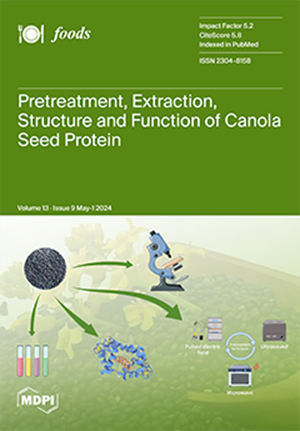探索植物发酵中花卉衍生乳酸菌的多样性和潜在用途:细胞外多糖生产的启示
IF 4.7
2区 农林科学
Q1 FOOD SCIENCE & TECHNOLOGY
引用次数: 0
摘要
分离新的植物源乳酸菌(LAB)是开发用于植物发酵的新型启动培养物的重中之重。本研究探讨了丹麦花卉中 LAB 的多样性及其用于植物性食品发酵的潜力。本研究共收集了 46 个花卉样本,涉及 34 个属,用于分离 LAB。通过引入富集步骤,共分离出 61 株 LAB,并使用 MALDI-TOF 和 16S rRNA 测序进行了鉴定。这些菌株代表了 9 个菌属中的 24 个菌种,主要是中肠亮菌(Leuconostoc mesenteroides)、果寡糖杆菌(Fructobacillus fructosus)、奥兹杏杆菌(Apilactobacillus ozensis)和昆明杏杆菌(Apilactobacillus kunkeei)。细胞外多糖生产的表型筛选显示,40 株菌株在含蔗糖的琼脂平板上表现出纤细或粗糙。高效液相色谱分析证实,所有分离菌株都能产生以葡萄糖、果糖或半乳糖为糖单体的胞外多糖。因此,这些菌株是葡聚糖、果聚糖和半乳糖的生产者。通过使用杏仁奶、燕麦奶和豆奶对这些菌株是否适合植物发酵进行了鉴定。结果表明,这三种植物基质都能成功酸化,但只观察到大豆中的白色念珠菌、魏氏菌、乳球菌、乳酸杆菌和果酸杆菌产生了质构。研究结果凸显了花源 LAB 菌株在大豆乳制品替代品质构发展中的潜力。本文章由计算机程序翻译,如有差异,请以英文原文为准。
Exploring the Diversity and Potential Use of Flower-Derived Lactic Acid Bacteria in Plant-Based Fermentation: Insights into Exo-Cellular Polysaccharide Production
Isolation of new plant-derived lactic acid bacteria (LAB) is highly prioritized in developing novel starter cultures for plant-based fermentation. This study explores the diversity of LAB in Danish flowers and their potential use for plant-based food fermentation. A total of 46 flower samples under 34 genera were collected for LAB isolation. By introducing an enrichment step, a total of 61 LAB strains were isolated and identified using MALDI-TOF and 16S rRNA sequencing. These strains represent 24 species across 9 genera, predominantly Leuconostoc mesenteroides, Fructobacillus fructosus, Apilactobacillus ozensis, and Apilactobacillus kunkeei. Phenotypic screening for exo-cellular polysaccharide production revealed that 40 strains exhibited sliminess or ropiness on sucrose-containing agar plates. HPLC analysis confirmed that all isolates produced exo-cellular polysaccharides containing glucose, fructose, or galactose as sugar monomers. Therefore, the strains were glucan, fructan, and galactan producers. The suitability of these strains for plant-based fermentation was characterized by using almond, oat, and soy milk. The results showed successful acidification in all three types of plant-based matrices but only observed texture development in soy by Leuconostoc, Weissella, Lactococcus, Apilactobacillus, and Fructobacillus. The findings highlight the potential of flower-derived LAB strains for texture development in soy-based dairy alternatives.
求助全文
通过发布文献求助,成功后即可免费获取论文全文。
去求助
来源期刊

Foods
Immunology and Microbiology-Microbiology
CiteScore
7.40
自引率
15.40%
发文量
3516
审稿时长
15.83 days
期刊介绍:
Foods (ISSN 2304-8158) is an international, peer-reviewed scientific open access journal which provides an advanced forum for studies related to all aspects of food research. It publishes reviews, regular research papers and short communications. Our aim is to encourage scientists, researchers, and other food professionals to publish their experimental and theoretical results in as much detail as possible or share their knowledge with as much readers unlimitedly as possible. There is no restriction on the length of the papers. The full experimental details must be provided so that the results can be reproduced. There are, in addition, unique features of this journal:
manuscripts regarding research proposals and research ideas will be particularly welcomed
electronic files or software regarding the full details of the calculation and experimental procedure, if unable to be published in a normal way, can be deposited as supplementary material
we also accept manuscripts communicating to a broader audience with regard to research projects financed with public funds
 求助内容:
求助内容: 应助结果提醒方式:
应助结果提醒方式:


